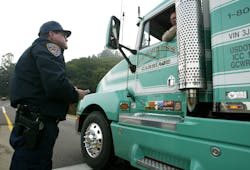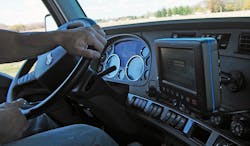Preparing for roadside inspections in the digital age
Carriers, add it to your list. Coming down the pike is a new roadside inspection category that you and your drivers need to get to know: electronic inspection.
Currently, trucking companies and drivers are concerned with the following seven roadside inspection categories:
- Full roadside inspection
- Walk around
- Driver only
- Special trend (for instance, operation brake check day)
- No driver present (typically a post-accident inspection)
- Radioactive loads
- Specialized – school bus/shuttle bus
According to Andy Blair, a retired police/DOT enforcement officer and owner of DOT Safety Checkups, electronic inspections will be set up similar to the current weigh-station PrePass model, in which a truck transmits wireless information as it passes a given point. The driver, most likely unaware he or she has gone through a checkpoint, won’t be pulled over by an enforcement officer, but an inspection report will be generated and subsequently sent to the carrier.
“This is kind of Big Brother-ish, but it hasn’t happened yet,” Blair said during Fleet Owner’s most recent webinar, Roadside inspections: How they are changing in the digital age. “And there’s no effective date quite yet, but it looks like it’s coming.”
Blair, along with Brad Penneau, safety program consultant for Telogis, discussed various upcoming regulatory changes, particularly surrounding ELD implementation, during the Sept. 7 webinar. The webinar was sponsored by Telogis, a Verizon Company.
So, how exactly will the ELD environment change the roadside inspection experience? Penneau advises fleets and drivers to prepare now.
“Every vehicle coming out today is already set up for connectivity,” he explained. “If you’re not taking advantage of that technology, you’re really doing yourself and your fleet a disservice.”
Based on the current state of inspections, Penneau explained that if drivers are stopped during an inspection and are determined to have false logs, they will get put out of service almost 72% of the time. But, he noted, early adopters of ELDs are finding the opposite is happening.
“The violation numbers seem to support that early adopters of ELDs are having a positive impact on the number of HOS violations,” Penneau said. “As more carriers transition to an ELD environment, we can expect the number of HOS violations to continue to decrease.”
The majority of the top 20 vehicle violations still relate to brakes, lights and tires, he added.
ELDs and what’s new for 2018
Though ELDs are one of the biggest concerns within the industry, Blair addressed additional new electronic rules that are expected to impact the industry.
In June 2018, medical providers will begin to electronically file drivers’ medical cards to the Dept. of Motor Vehicles (DMV). “If you don’t get your medical card into the DMV ahead of time, they will think you don’t have one and they will downgrade you,” Blair explained. “This will help prevent your CDL drivers from having to go to the DMV or having things faxed to the DMV. This will save you a step.”
Drivers will still be required to carry a paper copy of their medical cards for the first 15 days after obtaining a new medical card. “That will not change,” Blair explained. “A driver has to carry paper even if [the medical card] was already taken to the DMV because the DMV doesn’t always update things right away.”
Fleets also can expect some new changes when it comes to challenging crash preventability. As of June 1, carriers are now able to “data cue” crashes and submit proposals to FMCSA’s crash preventability demonstration program. The program, however, limits what carriers can claim as far as the type and nature of crashes they are able to challenge.
The following crash types are eligible for participation:
- A commercial motor vehicle (CMV) is struck by a motorist considered DUI, DWI, or under the influence
- A CMV is struck by a motorist driving in the wrong direction
- A CMV is rear-ended, and it is clearly not the commercial driver’s fault
- A CMV is struck while stopped or legally parked, including when the vehicle is unattended
- A CMV is struck by an individual committing or attempting to commit suicide by driving or stepping in front of the vehicle
- A CMV sustained disabling damage after striking an animal in the road
- A crash is a result of an infrastructure failing, such as falling trees, rocks, or debris from a storm
- A CMV is struck by cargo or equipment from another vehicle
And, as the industry is well aware by now, ELD day is Dec. 18. But Blair urges fleets to have an ELD in place before then or at least by Dec. 17. Carriers and owner-operators that have an AOBRD (automatic on-board recording device), even if it doesn’t meet the current ELD standards, will still be able to use that device until Dec. 16, 2019, to give them extra time to shop around for an ELD.
There are some exemptions to the ELD rule, including:
- Short haul provision: Short-haul drivers don’t have to go to an ELD if their carriers are short-haul exempt.
- The eight out of the rolling 30-day rule: In a given 30-day time period, a driver can run up to eight days’ worth of logs, and as long as he or she does not exceed the number eight in a rolling 30-day period, he or she can continue to file paper logs. However, if the driver exceeds that and goes into the ninth, 10th or 11th day, that would then require an electronic log, Blair explained.
- Model-year 1999 and older vehicles are exempt: “And I think the value of those older trucks has increased a little,” Blair noted. “Another nice little exemption they carved in is1999 and older powertrains in newer trucks. Those that are so inclined can take an older engine and put it in the newer truck, and it does go by the powertrain then.”
- Drive away/tow away operation businesses also qualify as exemptions.
- General powers of service, such as utility service providers, are exempt from every HOS regulation service in demand, Blair added.
For older vehicles, enforcement officers will determine ELD exemption status by the vehicle identification number (VIN), not necessarily the date of manufacture, Blair explained. If officers are unable to determine the age of the truck or the engine, they will flag the information on that inspection to the U.S. DOT for further investigation. Drivers who are going to claim an exemption should be prepared to back it up, Blair noted.
“If you have that newer truck with a 1998 engine, maybe have a printout or document showing some sort of a service listing this 2002 vehicle with this 1998 engine in it,” he said. “As a former officer, that would put me to rest and sort of settle the issue right there on the spot and not cause me to go any further to investigate.”
In addition, CVSA said it will not declare ELD out-of-service violations until April 1, 2018, to give law enforcement a couple of months to acclimate to the new processes. However, Blair did note that violations will still show up on an inspection report, and CSA points and written citations will be issued for ELD-related violations.
“What CVSA is saying is they will not put anyone out of service,” Blair stressed. “However, if you’re required to have a log and you have nothing at all, you will be put out of service for that kind of thing.”
About the Author

Cristina Commendatore
Cristina Commendatore is a past FleetOwner editor-in-chief. She wrote for the publication from 2015 to 2023.

